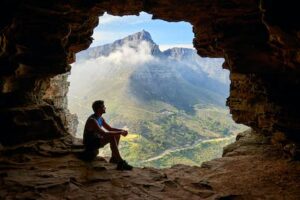Cave of Munits, nestled in the Santa Monica Mountains of Southern California, is a captivating natural wonder that beckons adventurers and nature enthusiasts alike. This hidden gem, shrouded in myth and mystery, offers more than just a physical journey into its depths—it invites visitors to delve into the rich tapestry of history and folklore that surrounds it.

Geological Marvels
The cave, also known as Castle Peak Cave, is a rocky enclave formed by sandstone outcrops. Its intricate formations tell the tale of geological processes that have unfolded over thousands of years. Visitors can marvel at the impressive rock structures, each telling a silent story of the forces that shaped the landscape.
Sacred Grounds
Beyond its geological allure, the Cave of Munits holds cultural and historical significance. Indigenous peoples, such as the Chumash and Tongva, considered this area sacred, leaving behind traces of their ancient presence. Exploring the cave becomes a journey through time, connecting modern adventurers with the spiritual practices and daily lives of those who once called it home.
Legends and Folklore
The cave’s enigmatic aura is heightened by the legends and folklore that surround it. One such tale involves a mythical figure named Munits, a rebellious Chumash youth who sought refuge in the cave after defying tribal norms. The stories vary, but they all contribute to the mystique of the cave, turning it into a place where history, myth, and imagination converge.
Hidden Treasures
As visitors navigate the rocky passages and chambers, they may encounter the remnants of past inhabitants—grinding stones, shell beads, and other artifacts that serve as archaeological breadcrumbs. These hidden treasures offer glimpses into the daily lives of the cave’s earlier occupants, providing a tangible connection to the human history embedded in its walls.
Flora and Fauna
Surrounding the cave is a vibrant ecosystem that adds to its allure. Native plant species, adapted to the arid climate, cling to the rocky terrain, creating a delicate balance of life. Observant hikers might spot local fauna, from lizards basking in the sun to birds soaring overhead. The cave thus becomes a microcosm of the larger ecological wonders within the Santa Monica Mountains.
Preservation Challenges
Despite its cultural and ecological significance, the Cave of Munits faces challenges related to preservation. Increased visitation and human impact can erode the delicate features of the cave, threatening its geological formations and archaeological remnants. Balancing public access with conservation efforts becomes crucial to ensuring that future generations can experience the magic of this unique site.
Guided Exploration
For those eager to explore the Cave of Munits, guided tours offer a responsible and educational way to experience its wonders. Knowledgeable guides can share insights into the geological processes, cultural history, and ongoing conservation efforts. This approach encourages a deeper appreciation for the site and fosters a sense of stewardship among visitors.
Respecting Nature’s Sanctuary
As with any natural wonder, responsible tourism is paramount. Visitors are urged to adhere to Leave No Trace principles, minimizing their impact on the delicate ecosystem. Respecting the cave’s cultural and historical significance involves refraining from disturbing artifacts and treating the site with the reverence it deserves.
This comprehensive guide will help you plan and navigate your journey through this unique cave.
Location:
The Cave of Munits is located in El Escorpion Park, within the Upper Las Virgenes Canyon Open Space Preserve. The park entrance is off Victory Boulevard in West Hills, Los Angeles. Follow signs to El Escorpion Park and park in the designated areas.
Trailhead:
Begin your adventure at the main trailhead, leading to the cave. The trail is well-marked and moderately challenging, providing an enjoyable hike through scenic landscapes.
Hiking Tips:
Wear sturdy hiking boots for rocky terrain.
Bring plenty of water, especially on warm days.
Pack a map or use a GPS device to stay on the designated trail.
Respect the natural environment and follow Leave No Trace principles.
Cave Entrance:
Approaching the Cave of Munits, you’ll notice its impressive sandstone formation. Exercise caution when entering the cave, as the path may be uneven. Flashlights are recommended to explore the cave’s inner chambers.
History and Legends:
The Cave of Munits has historical significance for the Native American Chumash people. Legend has it that Chief El Escorpion sought refuge in the cave during conflicts. Respect the site’s cultural importance and refrain from disturbing any artifacts.
Inside the Cave:
The cave’s interior reveals stunning rock formations, creating a unique atmosphere. Be mindful of the natural habitat and avoid touching or removing anything. Take time to absorb the tranquility and echoes within the cave.
Photography Tips:
Capture the cave’s beauty with these tips:
Use natural light to highlight textures.
Experiment with angles to showcase the cave’s depth.
Be respectful of fellow hikers when taking photos.
Safety Precautions:
Inform someone of your hiking plans.
Check weather conditions before embarking on your journey.
Stay on designated trails to minimize environmental impact.
If exploring the cave’s interior, watch for slippery surfaces.

As one might anticipate, the area sees its fair share of visitors who may not fully embrace the Leave No Trace wilderness ethic. While navigating the terrain, stay alert to the presence of broken glass on the cave floor. Despite the litter, light graffiti, bird droppings, and remnants of modern “spiritual gatherings,” stepping into this cavern remains an extraordinary experience.
For those seeking an extra dose of adventure, it’s feasible to ascend through one of the cave’s chimneys, scramble up the mountainside, and follow an unmaintained trail along the ridgeline leading to Castle Peak. However, it’s crucial to note that this route is suitable only for seasoned scramblers and climbers.
After immersing yourself in the cave’s wonders, cautiously retrace your steps to the use trail and make your way back to the Hunter Allen Trail/fire road at 1.9 miles. Follow the fire road back to the trailhead. If you’re yearning for a more extended hike, consider extending your journey with a loop around Lasky Mesa from the Victory Trailhead, creating a satisfying figure-eight route within the park.
Conclusion:
The Cave of Munits offers a memorable adventure, blending nature, history, and folklore. By respecting the environment and understanding the site’s significance, you can enjoy a rewarding experience in this captivating corner of Southern California. The Cave of Munits, with its geological marvels, cultural significance, and tales of myth and legend, stands as a testament to the interconnectedness of nature and human history. It invites us to explore not only its physical depths but also the depths of our curiosity and respect for the past. As stewards of this natural sanctuary, we hold the key to ensuring that the cave’s magic endures for generations to come.


